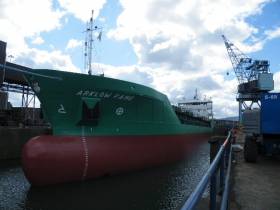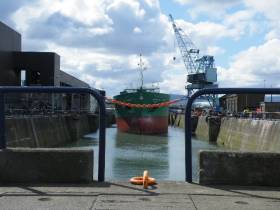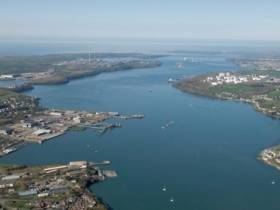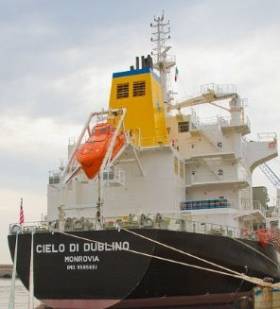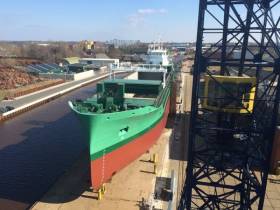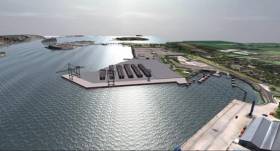Displaying items by tag: Port and Shipping News
#BoatyardKillybegs – A pair of tugs in recent weeks have undergone overhaul work carried out at Mooney Boats, the boatbuilder, repairer and maintenance facility in Killybegs, Co. Donegal, writes Jehan Ashmore.
Tugs SMS Cian and Nomad used the services of the north-western yard that has the largest boat-hoist in Ireland, though Killybegs fleet of considerably larger supertrawlers go elsewhere. Among the drydocks used this had included Dublin Graving Docks that closed last week.
SMS Cian which operates for Sinbad Marine Services also based in Killybegs, was taken out of the water where the 30 ton bollard pull tug had seacocks removed, serviced and refitted.
In addition the 18m twin screw vessel had a stainless steel bar fitted to the top of the gunnel on the stern. The UK flagged SMS Cian was washed and painted along with new anodes fitted where required.
The rather unusual looking Nomad, having observed at Dun Laoghaire Harbour in 2009 (see below) is currently operated by Castletownbere Marine Ltd.
Work on the 10 ton bollard pull tug formerly the States of Jersey Harbour Authority tug, Duke of Normandy, involved water-blasting the deck and deckhouse in resealing the windows around the wheelhouse.
The 1972 built tug completed at Poole, Dorset, was also washed, painted and had anodes fitted to the 24m single screw vessel during her call to Killybegs.
The premier Irish fishing port is also from where Nomad previously operated for Sinbad Marine in duties asides towage but on oil spill recovery, fire fighting and as a guardship.
It was in that role that Nomad saw east coast duties off the Kish Bank, using Dun Laoghaire as a base. On that occasion the tug was on 'guard vessel' duties of Dublin Port based drillship, Fugro Synergy which carried out a series of exploratory drill wells off the Kish Bank to examine the viability of a underground coal gasification (UCG) project south-east of the iconic lighthouse.
#ShippingReview - Jehan Ashmore reviews the shipping scene over the last fortnight.
Containership Antwerp called to Dublin on Maersk Group’s first direct call to the capital on a new Seago Line operated UK-Ireland-Spain service.
The ship is a sister of Maersk Alabama which Somali pirates hijacked in 2009. The story was made into a film 'Captain Phillips' played by actor Tom Hanks.
M.V. Ireland launched in the Netherlands, has no connections with the Irish shipping industry, however the newbuild is noteworthy given the vessel is one of the first dry cargoships to be powered by (LNG) liquefied natural gas.
All “shippers” as from July 2016 must declare to the carrier in advance the verified weight of packed containers.
Arklow Fame (90m) on Wednesday became the final ship to depart the country’s largest dry-dock (200m) in Dublin that officially closed yesterday. The unique strategic facility of Dublin Graving Docks Ltd had employed a skilled workforce of 26 at the Alexandra Basin site which is to be redeveloped.
The demise of the ship-repairer and engineering facility marks the end of a era in this chapter of the Irish maritime industry with the exception of Cork Dockyard, now the largest in the state.
The 2,998 tonnes Arklow Fame, one of the smaller vessels to use Dublin dry-dock, has since Thursday berthed at the Bulk Jetty within Alexandra Basin. Cargo transported by train from Boliden Tara Mines (ore for zinc and lead) was loaded on board the leadship of 10 'F' class Spanish built sisters.
The cargoship yesterday departed for Odda, Norway.
#DryDockClosing – Its the end of an era as the nation’s largest dry dock is to close with the loss of 26 jobs as Dublin Port Company are to infill the site as part of the €227m Alexandra Basin Redevelopment (ABR) project, writes Jehan Ashmore.
Dublin Graving Docks Ltd has operated Graving Dock No. 2 since 2002 under licence from Dublin Port Company. In recent years the marine engineering business have fought to retain the ship repair, maintenance and conversion facility, however the license expires tomorrow.
The shiprepairer had generated about €2.5m annually. Around 20 vessels have dry-docked each year. Vessels are mostly cargoships/short sea traders, dry bulk-carriers, ro-ro freight ferries, large trawlers, the port company's tugs and in 2014 the tallship Jeanie Johnston. Previous owners of the drydock worked on ferries which are now larger and go elsewhere, not including Cork Dockyard.
For almost 60 years the 220m long dry dock which can handle one large or two smaller vessels at a time has served Irish owned ships and from overseas clients. The final ship to have worked carried out at the 1957 built dry dock was the 90m cargoship Arklow Fame. The 2,998 tonnes vessel called in mid-April and was floated-out with a departure yesterday afternoon.
Dublin Graving Docks had submitted a final observation to the An Bord Pleanála hearing held last year on the ABR which is a Strategic Infrastructure Development that was granted planning permission last summer. The decision leaves the capital port without a strategic ship repair and engineering facility.
The main reason why Dublin Port want to re-use this part of their port estate is to gain a higher financial yield per acre of land through the redevelopment of Alexandra Basin.
The ABR project is to enable much larger and deeper drafted cargoships and the largest cruiseships in the world to berth at a dedicated €30m cruise terminal located closer to the city centre.
Dublin Graving Docks cited they were not opposing the accommodation of giant cruise ships but they were against the reconfiguration and the scale involved in the ABR project.
At approximately 1.4 hecteres the area including the dry dock can handle ships up to 6.5m draft and is accessed by a dock gate 24.5m wide. Under the project this entrance is be blocked with a reconfigured quayside and consequent in-fill of the dry-dock to create additional space. As the port has broken trade figures this has led to critical requirement for additional capacity to cope with demand.
The ABR will be the biggest single infrastructure capital investment development to be undertaken in the past 200 years of the port. Also the project marks phase one of Dublin Port's Masterplan 2012-2040.
Positive Results for UK Energy Port of Milford Haven
#PortProfits – The Chief Executive of the Port of Milford Haven has praised staff for delivering strong performance in tough trading conditions at the UK’s biggest energy port.
The south Wales port has published its accounts for 2015, showing the Pembrokeshire port recorded a profit before tax of £4.4m. The port experienced net growth in cargo volumes, up by over 10% on 2014 levels, at 37.8 million tonnes.
Valero remained consistently busy and the Port benefited from a continued increase in volumes of LNG. The storage terminals at SemLogistics and Puma Energy also saw reasonable levels of activity.
Chief Executive at the Port of Milford Haven, Alec Don, welcomed the results. “Not only has the port remained busy, it has also attracted new business to the area,” he said. “We have continued to invest in both services and facilities to ensure we can maintain the port’s status as the UK’s biggest gateway for seaborne energy products. Considerable praise must go to our staff. Their skill and dedication has kept the port running efficiently and effectively,” he added.
Investment in operations up-river at Pembroke Port also yielded results. The port remained South Wales’ largest and most successful ferry terminal. It also attracted a new contract to handle and ship out refuse-derived fuel to Sweden. The diversification strategy to attract manufacture and maintenance contracts for marine renewables took a leap forward at the end of 2015 with the deployment of Tidal Energy Limited’s prototype device, DeltaStream, constructed in the port.
The Port of Milford Haven also owns and operates Milford Dock and Marina, base of Wales’ largest fishing port. Planning approval for a wholesale redevelopment of the area was secured in 2015, paving the way for further investment and modernisation.
“Last year saw significant improvements both in the water, with new lock gates bringing significantly enhanced and shortened passage times into and out of the docks and marina, and by the water with new fish handling and processing facilities,” said Alec.
“Our strategy to invest in the growth of fish handling, processing and retail will also be a catalyst for further business activity here,” he added. “Across the docks we have laid the foundations for comprehensive development that will see new retail and visitor attractions built. In turn, this will generate jobs and encourage further inward investment.”
“We are investing for the future. However, this can only be achieved through close collaboration with partners and in a business environment that makes it easy to invest, operate and employ.”
Shipping Review: Arklow's First ‘Valiant’, d’Amico’s 'Green' Award, 2015 A 'Success' for Irish Ports & More
#ShippingReview - Jehan Ashmore reviews the shipping scene over the last fortnight.
Arklow Shipping's third Bodewes built 5,150dwt Trader, Arklow Valiant was launched as the first in the company’s 50th year to bore that name. The cargsoship features a new bow differing to her sisters completed at the same Dutch yard.
Around €1 million is been spent at Dun Laoghaire Harbour on repairs and maintenance on the popular amenity of the East Pier and on the Carlisle Pier where only small cruiseships can berth.
d'Amico Group, the Italian company which has a dry-cargo subsidiary headquartered in Dublin, has won 'Green Shipowner of the Year' at an award held in the Danish capital, Copenhagen.
The Irish Maritime Transport Economist report for 2015 has been a successful year for the maritime industry. The annual publication is issued by the Irish Maritime Development Office (IMDO).
Cargoships loaded in Scotland docked in Rosslare Europort, where the outlook in the timber trade is for further growth at the ferryport.
d’Amico Group is 'Green Shipowner of the Year 2016'
#GreenAward - The d'Amico Group, the Italian maritime transport company has won the "Green Shipowner of the Year" 2016 for commitment in implementing on its fleet a system able to reduce the environmental impact and constantly monitor the performance of energy consumption. The company's dry-cargo subsidiary, d'Amico Dry domiciled in Dublin, operates a range of modern tonnage.
advanced sensors on board, which allow to track consumption and performance in real time, led to a deeper responsibility assignment of the crew on environmental issues”, stated Domenico Savio Taiano, HSQE Director of d'Amico Group. Besides these engineering solutions, which already allow considerable reduction of fuel consumption and emissions (CO2, SOx and NOX), d’Amico Group established a Performance Monitoring Department, standing out among the first shipowner companies, specialized in transporting dry and liquid bulk cargos, able to create a department focused on monitoring the whole fleet performance exclusively.
The jury that selected the projects comprised Craig Eason (Deputy Editor, Lloyd's List), George Papagiannopoulos (Common Progress), Lars Robert Pedersen (COO, BIMCO), Mark Cameron (COO, Ardmore Shipping), Hanna Lee Behrens (Norwegian Shipowners' Association). d’Amico Group has always settled among its “core values” a strong commitment to the environment. The environmental policy and the plans on sustainable development are, and will still be, important pillars of the strategy of the Group.
#ItsALLnew – It will be a first for Arklow Shipping now in their 50th year as a new general cargoship launched tomorrow is to be bestowed with the name Arklow Valiant, writes Jehan Ashmore.
Also setting a new departure for the 'Valiant' is a considerably different bow design when compared to a previous pair of completed sisters, Arklow View and leadship Arklow Vale. The latter single-hold cargsoship which is designed with energy-saving bow characteristics is currently docked in Dublin Port today.
Arklow Valiant represents the third of the Royal Bodewes Eco-Trader 5,100dwt series built to the Dutch shipyard’s own design. The newbuilding no.723 is to be launched tomorrow morning at Hoogezand on th outskirts of Groningen.
To compare the new design of the bow, click previous footage here of Arklow Vale and that of a photo of newbuild on her first call to Dublin Port in January.
The cargoship is one of a 10 ship order by Arklow Shipping. They will serve Dutch division, Arklow Shipping Nederland B.V. based in Rotterdam and among the bulk dry cargoes they will transport this will include grain, animal feed and steel rails.
A previous generation of ‘V’ class vessels but built to a different design were disposed last year by ASL. The ageing trio were named Arklow's Viking, Venture and Vale.
New Operation Takes Over Only Ireland-Wales Container Service
#NewOperation - A new operation has taken over the running of the only Ireland-Wales container service, writes Jehan Ashmore.
Cronus Logistics having taken over Cardiff Container Lines, have engaged with Associated British Ports (ABP) through incorporating one of their ports, the Port of Cardiff into its Irish Sea schedule. The takeover provides Cronus to strengthen and plan its expansion of Ireland-UK gateways between Warrenpoint, Dublin, Cardiff and Bristol.
The new operation will enable Cronus to offer cargoes and also specialising in the steel, forestry and building sectors to these Irish Sea and Bristol Channel ports. The call to Bristol did not feature in Cardiff Container Lines feeder network operated by Coronel as reported on Afloat a year ago.
Afloat has identified the pair of containerships that Cronus are operating on this expanded Irish Sea feeder network, they are Vanquish and Vanquish 2. Each vessel can take 45 foot curtain-sided or box containers as 20ft and 40ft boxes and refrigerated containers plus the ability to take out of gauge cargo.
At the Port of Cardiff is the 14-acre railhead that provides a connected rail terminal linking directly into the UK national rail network opening up potential new markets.
Also serving the Welsh capital Cardiff, are full-length intermodal trains which will now be discharged and loaded directly into the terminal. With an increase in rail traffic, Cardiff also has a large area of open and covered storage next to the railhead that can easily accommodate large shipments.
Irish cargoes can also benefit from onward transit from both Cardiff and Bristol on the Borchard Lines West Mediterranean service with sailings every 5 days. The routes serving the Mediterranean sail to/from Leixoes, Castellon, Salerno, Piraeus, Limassol, Ashdod, Haifa, Beirut, Alexandria, Mersin and Salerno.
As such Cronus Logistics via the Port of Dublin is now also acting as the weekly feeder service to the Line.
Detained Scottish Timber Trading Cargoship Finally Departs Port
#Detained- A cargoship from Scotland that was detained in Wicklow Port for a more than a week including St. Patrick's Day, finally departed last night bound for Belfast, writes Jehan Ashmore.
The 674 tonnes Burhou I was detained by Port State Control at Wicklow Port, having discharged a cargo of round timber from Kyle of Lochalsh in western Scotland. This is a regular trade to the port as featured previously on Afloat.
Burhou I is a Belize flagged small coaster which was detained following an inspection by authorities. The detention surrounded a single technical deficiency to resolve, before the ship departed yesterday in the early evening.
The detention of the 58m long Burhou I involved having to shift berths within Wicklow Harbour. This led to the cargoship berthing alongside the non-commercial East Pier.
It is from this vantage point where spectators gather to watch the Round Ireland Yacht Race hosted by the nearby Wicklow Sailing Club located at the foot of the pier.
The veteran cargsoship built by a German yard in 1978 is a sister of Isis (see, visit to Ramsey, Isle of Man). Both coasters have self-loading and discharging capabilities to transport a variety of cargoes among them timber felled in Scotland.
These coasters regularly trade throughout the Irish Sea and also to ports in south-west England. In addition they provide a domestic freight service to the smaller harbours in the Scottish Outer Isles.
Also in the port during the week was the 82m long Nestor. This was only the second call to the port of the 2,452 tonnes cargoship that loaded scrap metal in recent days and departed for Liverpool.
Shipping Review: ICG’s 2015 Results, MEP's Vote in Port Regulation, Tenders for Cork's €100m Terminal
#ShippingReview – Jehan Ashmore reviews the shipping scene over the last fortnight.
Container and ferry operator, Irish Continental Group released preliminary results for 2015 which reported positive operational and financial performance building upon the continued Irish economic recovery.
Danish logistics and shipping operator DFDS are to double intermodel rail capacity between Port of Waterford and Ballina, Co. Mayo.
The European Parliament’s Transport committee of voted in favour on the Port Regulation and the Fleckenstein Report. 451 MEPs voted in favour, 234 MEPs voted against, while 18 MEPs abstained.
A date for tenders for the €100 million redevelopment of the Port of Cork's Ringaskiddy container terminal are to be received no later than next Wednesday, 23 March.
Royal Bodewes latest shipyard, to be named Arklow Valiant features a different bow compared to her sisters. Both the fore and aft sections of the cargoship were joined together at the Dutch yard.
The largest ever con-ro built, Atlantic Star of 100,530 tonnes (off Anglesey) and future G4 sisters will operate on ACL's Europe-North American (Halifax, Canada) service which is to be maintained in a new deal to 2022.


























